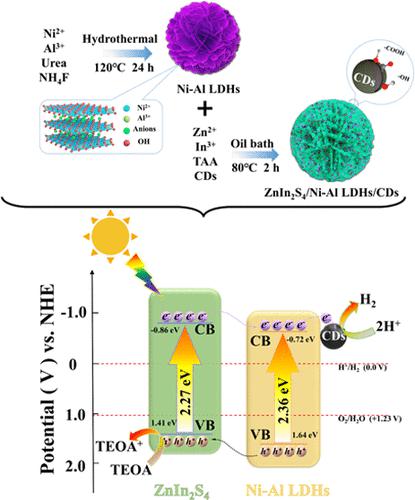当前位置:
X-MOL 学术
›
Inorg. Chem.
›
论文详情
Our official English website, www.x-mol.net, welcomes your
feedback! (Note: you will need to create a separate account there.)
Carbon-Dots-Modified Hierarchical ZnIn2S4/Ni–Al LDH Heterojunction with Boosted Charge Transfer for Visible-Light-Driven Photocatalytic H2 Evolution
Inorganic Chemistry ( IF 4.3 ) Pub Date : 2023-06-07 , DOI: 10.1021/acs.inorgchem.3c01317 Xiuzheng Deng 1 , Dongxue Wu 1 , Jiawen Ding 1 , Jian Rong 2 , Jinfeng Mei 2 , Qian Liang 1 , Zhongyu Li 1, 2
Inorganic Chemistry ( IF 4.3 ) Pub Date : 2023-06-07 , DOI: 10.1021/acs.inorgchem.3c01317 Xiuzheng Deng 1 , Dongxue Wu 1 , Jiawen Ding 1 , Jian Rong 2 , Jinfeng Mei 2 , Qian Liang 1 , Zhongyu Li 1, 2
Affiliation

|
The construction of a heterojunction structure is considered a significant route to promote solar-driven H2 production. Herein, a CDs/ZnIn2S4/Ni–Al LDHs (CDZNA) ternary heterojunction was elaborately constructed via the in situ growth of ZnIn2S4 on Ni–Al LDHs with the incorporation of carbon dots (CDs) cocatalyst, which was used as a highly efficient catalyst for the photocatalytic H2 generation. Characterizations indicated that 2D ZnIn2S4 nanosheet homogeneously dispersed on the surface of Ni–Al LDHs fabricated an intimate hierarchical architecture and provided a high BET surface area (135.12 m2 g–1). In addition, the unique embeddable-dispersed CDs as electron mediators possessed numerous active sites and promoted the charge separation on ZnIn2S4/Ni–Al LDHs (ZNA) binary catalyst. By coupling these two features, the CDZNA catalyst exhibited a considerable H2 production rate of 23.1 mmol g–1 h–1 under visible-light illumination, which was 16.4 and 1.4 times higher than those of ZnIn2S4 and ZNA, respectively. A proposed mechanism of photocatalytic H2 production over the CDZNA catalyst was also discussed. This work provides a promising strategy to achieve highly efficient solar energy conversion in a ternary photocatalytic system.
中文翻译:

碳点修饰的分层 ZnIn2S4/Ni-Al LDH 异质结具有增强的电荷转移能力,用于可见光驱动的光催化产氢
异质结结构的构建被认为是促进太阳能驱动的H 2生产的重要途径。在此,通过在Ni-Al LDHs上原位生长ZnIn 2 S 4并掺入碳点(CDs)助催化剂,精心构建了CDs/ZnIn 2 S 4 /Ni-Al LDHs(CDZNA)三元异质结,用作光催化H 2生成的高效催化剂。表征表明 2D ZnIn 2 S 4均匀分散在 Ni-Al LDH 表面的纳米片形成了紧密的分层结构,并提供了高 BET 表面积(135.12 m 2 g –1)。此外,独特的可嵌入分散的碳点作为电子介体,拥有大量的活性位点,促进了ZnIn 2 S 4 /Ni-Al LDHs (ZNA)二元催化剂上的电荷分离。通过耦合这两个特性,CDZNA催化剂在可见光照射下表现出高达23.1 mmol g –1 h –1的H 2产率,分别是ZnIn 2 S 4的16.4和1.4倍。和郑州日产。还讨论了CDZNA催化剂上光催化H 2生产的拟议机制。这项工作为在三元光催化系统中实现高效太阳能转换提供了一种有前景的策略。
更新日期:2023-06-07
中文翻译:

碳点修饰的分层 ZnIn2S4/Ni-Al LDH 异质结具有增强的电荷转移能力,用于可见光驱动的光催化产氢
异质结结构的构建被认为是促进太阳能驱动的H 2生产的重要途径。在此,通过在Ni-Al LDHs上原位生长ZnIn 2 S 4并掺入碳点(CDs)助催化剂,精心构建了CDs/ZnIn 2 S 4 /Ni-Al LDHs(CDZNA)三元异质结,用作光催化H 2生成的高效催化剂。表征表明 2D ZnIn 2 S 4均匀分散在 Ni-Al LDH 表面的纳米片形成了紧密的分层结构,并提供了高 BET 表面积(135.12 m 2 g –1)。此外,独特的可嵌入分散的碳点作为电子介体,拥有大量的活性位点,促进了ZnIn 2 S 4 /Ni-Al LDHs (ZNA)二元催化剂上的电荷分离。通过耦合这两个特性,CDZNA催化剂在可见光照射下表现出高达23.1 mmol g –1 h –1的H 2产率,分别是ZnIn 2 S 4的16.4和1.4倍。和郑州日产。还讨论了CDZNA催化剂上光催化H 2生产的拟议机制。这项工作为在三元光催化系统中实现高效太阳能转换提供了一种有前景的策略。


















































 京公网安备 11010802027423号
京公网安备 11010802027423号